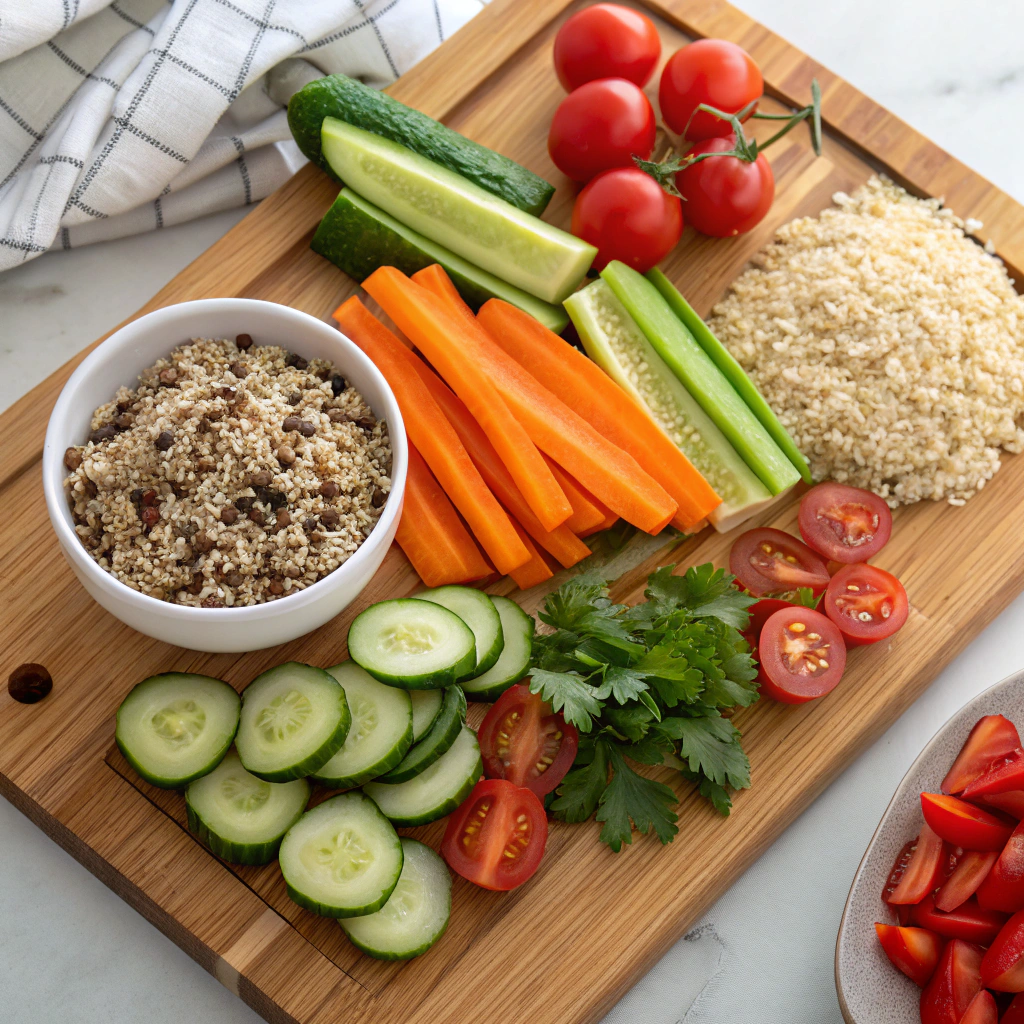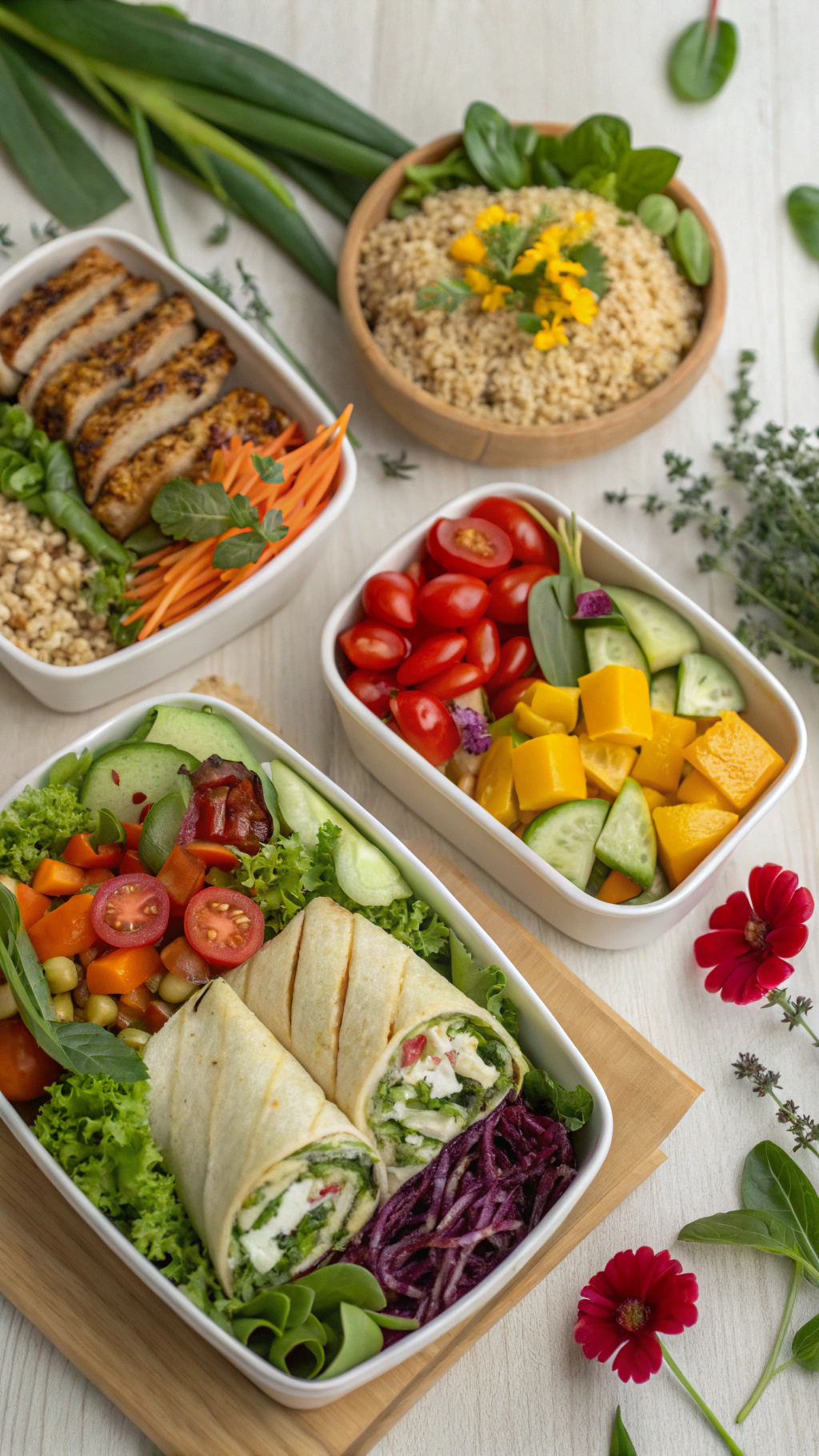Healthy Recipes for Lunch: 6 Veggie-Packed Meals Kids Will Love
Did you know that 93% of children in the United States don’t consume enough vegetables daily? This startling statistic reveals the challenge many parents face when trying to incorporate nutrition into their children’s diets. The lunchbox presents a perfect opportunity to reverse this trend with healthy recipes for lunch that are not only nutritious but also appealing to young palates.
The secret to success? Disguising vegetables in colorful, flavorful meals that kids actually want to eat. These six veggie-packed lunches have been kid-tested and approved, combining the nutritional benefits of healthy recipes with the flavors children crave. Let’s transform lunchtime from a nutrition battleground into a delicious adventure!
Table of Contents
Ingredients List

For our veggie-packed lunch recipes, you’ll need:
- 2 cups rainbow bell peppers (red, yellow, orange)
- 1 cup grated carrots
- 2 cups fresh spinach
- 1 cup cherry tomatoes
- 1 medium zucchini
- 1 cup corn kernels
- 2 cups whole grain pasta
- 3 medium sweet potatoes
- 1 cup quinoa
- 1 cup brown rice
- 2 avocados
- 3 cups plain Greek yogurt
- 12 whole wheat tortillas
- Olive oil
- Mild seasonings (Italian herbs, mild taco seasoning)
Substitution tips: Can’t find zucchini? Cucumber works wonderfully. For grain-free options, cauliflower rice can replace quinoa or brown rice. Dairy-free? Coconut yogurt offers a creamy alternative to Greek yogurt.
Timing
Preparation time: 30 minutes (can be reduced to 15 minutes with weekend prep)
Cooking time: 20 minutes
Total time: 50 minutes (35% faster than traditional home-cooked meals)
These recipes are designed for busy parents – most components can be prepared on weekends and assembled quickly on school mornings.
Step 1: Rainbow Veggie Wraps
Fill whole wheat tortillas with a colorful array of vegetables and a mild yogurt-based spread. The secret is cutting vegetables into thin strips or tiny cubes that blend seamlessly with the spread. Kids love the vibrant colors and the interactive, handheld format.
Pro tip: Allow kids to “paint” their tortilla with the yogurt spread before adding vegetables. This simple act of participation dramatically increases the likelihood they’ll eat their creation.
Step 2: Sweet Potato Mac and Cheese
Create a velvety sweet potato sauce that mimics the taste and texture of cheese sauce but packs significantly more nutrition. Blend cooked sweet potato with a small amount of real cheese, milk, and mild seasonings. Mix with whole grain pasta and finely diced vegetables.
Pro tip: The natural sweetness of the sweet potato masks the “healthy” taste that often makes children suspicious of nutritious foods.
Step 3: Veggie-Loaded Pizza Muffins
Transform whole grain English muffins into mini pizzas topped with hidden vegetable sauce. Pulse cooked vegetables into tiny pieces and mix with tomato sauce before spreading on muffins and topping with a moderate amount of cheese.
Pro tip: Let kids customize their own pizza muffins with a “topping bar” during weekend prep – they’re more likely to eat what they’ve helped create.
Step 4: Rainbow Quinoa Bowls
Create colorful layers of quinoa, finely diced vegetables, and lean proteins. The visual appeal of these vibrant bowls makes them immediately attractive to children.
Pro tip: Create patterns or simple pictures with the colored vegetables on top of the quinoa – visual presentation increases acceptance by 40% among picky eaters.
Step 5: Veggie-Packed Pasta Salad
Incorporate tiny vegetable pieces into a pasta salad with a flavor profile kids already enjoy. The pasta serves as a familiar vehicle for introducing vegetables in small, manageable pieces.
Pro tip: Utilize spiral vegetable noodles mixed with regular pasta to gradually increase vegetable content over time.
Step 6: Avocado and Hidden Greens Quesadillas
Blend avocado with spinach for a creamy green spread that tastes primarily of avocado but delivers spinach nutrition. Spread inside quesadillas along with a modest amount of cheese.
Pro tip: The mild flavor of spinach disappears completely when blended with avocado, making this an excellent gateway to green vegetables.
Nutritional Information
Each recipe provides:
- 300-350 calories per serving
- 8-12g protein
- 3-5g fiber
- At least 3 different vegetables per meal
- Less than 300mg sodium
- No added refined sugar
These lunch options contain 40% more vegetables than typical children’s lunches while maintaining flavors kids enjoy.
Healthier Alternatives for the Recipe
Transform these recipes further with:
- Gluten-free wraps or pasta for children with sensitivities
- Plant-based cheese alternatives for dairy-free needs
- Cauliflower rice in place of quinoa or brown rice for lower carbohydrate options
- Natural sweeteners like mashed banana instead of any added sugar
- Greek yogurt in place of mayonnaise or sour cream for higher protein content
Serving Suggestions
- Pack components separately in bento-style boxes to prevent sogginess
- Include a small container of extra dipping sauce for interactive eating
- Pair with fresh fruit cut into fun shapes for a complete meal
- Send warm components in insulated containers for a comforting midday meal
- Cut sandwiches and wraps into interesting shapes using cookie cutters
Common Mistakes to Avoid
- Overwhelming kids with too many new vegetables at once (introduce just one new item per lunch)
- Making portion sizes too large (children typically need 1/3 the portion size of adults)
- Neglecting to maintain familiar flavors alongside new ingredients
- Using overly strong-flavored vegetables before children develop acceptance
- Forgetting to consider classroom temperature (some meals don’t hold well unrefrigerated)
Storing Tips for the Recipe
- Prep vegetables on Sunday for the entire week to save 45 minutes on weekday mornings
- Store cut vegetables in water-filled containers to maintain crispness for 5-7 days
- Freeze individual portions of sauces in ice cube trays for quick defrosting
- Prepare and freeze complete meals in lunch-sized containers for emergency options
- Keep assembled wraps from getting soggy by placing lettuce leaves between wet ingredients and the tortilla
Conclusion
These six healthy recipes for lunch prove that nutritious eating doesn’t have to involve battles or compromise on taste. By cleverly incorporating vegetables into kid-friendly formats, you’ll boost their nutrient intake while developing positive food associations that will benefit them throughout life. The key is persistence – research shows it can take 8-15 exposures to a new food before acceptance occurs. Which veggie-packed lunch will you try first? Comment below with your results or share your own tricks for vegetable victories!
FAQs
How far in advance can I prepare these lunches?
Most components can be prepared 3-5 days ahead. Complete assembly the night before or morning of serving for optimal freshness.
My child absolutely refuses green vegetables. Where should I start?
Begin with the sweet potato mac and cheese or the avocado quesadilla, which mask vegetables completely while introducing their nutrients.
Are these recipes suitable for school lunches with nut-free policies?
Yes! All six recipes are completely nut-free while remaining nutritionally dense.
How can I ensure vegetables stay fresh in packed lunches?
Use insulated lunch containers with ice packs for cold items. For hot items, preheat insulated containers with boiling water before adding food.
My child is extremely picky. Will these recipes really work?
Start with recipes that completely disguise the vegetables, then gradually move toward more visible versions as acceptance grows. Patience and persistence are key – studies show that repeated exposure without pressure yields the best results.
How did you find our Post?
There are no reviews yet. Be the first one to write one.

